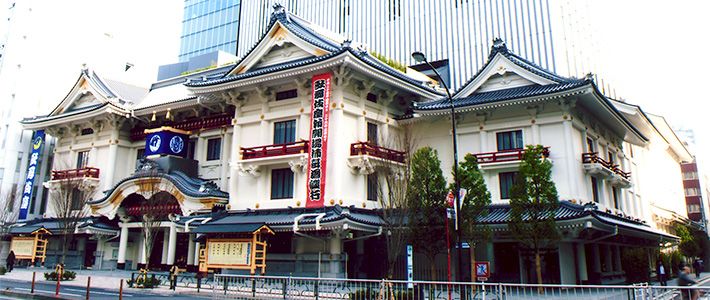
The Curtain Rises on an All-New Kabukiza
Culture- English
- 日本語
- 简体字
- 繁體字
- Français
- Español
- العربية
- Русский
Known in Japanese as the “temple of kabuki” and the home of the performing art, the Kabukiza in Tokyo’s Ginza district reopened its doors on April 2 after three years of renovation. The first Kabukiza opened its doors in 1889; today the theater is in its fifth incarnation, which has inspired people in the kabuki world to dub it “Kabukiza V” in the style of an actor taking a traditional stage name.
The Kabukiza has undergone several rebirths during its more than 120 years of history and tradition. The first Kabukiza was a three-story building with a Western-style exterior and Japanese-style interior finished in Japanese cypress. In 1911, the exterior was extensively renovated in a purely Japanese “palatial” style, and the second Kabukiza was born.
In 1921 the building was lost to a fire caused by an electrical fault. Construction started on the third building, designed in reinforced concrete by Okada Shin’ichirō (1883‒1932) with a large hafu gabled roof taking its architectural cue from the Azuchi-Momoyama period (1568–1603). (Hafu refers to the triangular section at the end of a gable or gambrel roof. These features can be seen on many Japanese buildings, such as temples and shrines.) When the 1923 Great Kantō Earthquake struck midway through construction, fires following the quake damaged the interior, putting a temporary halt to construction temporarily halted. In 1924 the building was inaugurated at last, though, and the Kabukiza entered its golden age in its third form.
This theater was only to last until 1945, though, when much of it was incinerated in the World War II air raids. In the immediate postwar era, workers overcame serious material shortages to erect the fourth Kabukiza as a faithful reproduction of the third. Completed in 1951, this incarnation was built to the design of Yoshida Isoya (1894‒1974), a well-known proponent of the sukiya-zukuri architectural style that borrowed liberally from traditional tea-house aesthetics and made heavy use of natural materials. This would prove to be the longest-lived version of the Kabukiza: over the next 60 years the fourth theater hosted countless performances and earned the love of the artists and audiences. But the building deteriorated over time, necessitating the most recent renovation.
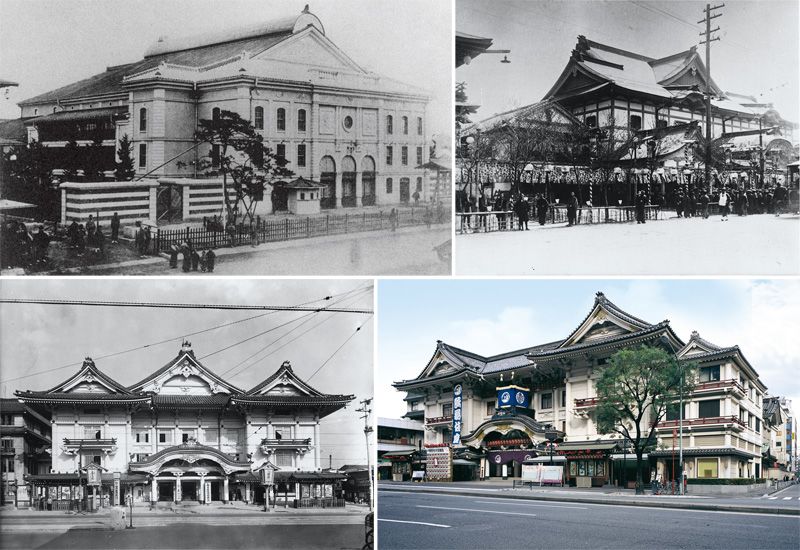 The theater through the years. Above: The first (left) and second Kabukiza. Below: The third (left) and fourth Kabukiza. (Photos courtesy Shōchiku Co., Ltd.)
The theater through the years. Above: The first (left) and second Kabukiza. Below: The third (left) and fourth Kabukiza. (Photos courtesy Shōchiku Co., Ltd.)
Inherited Tradition in the Details
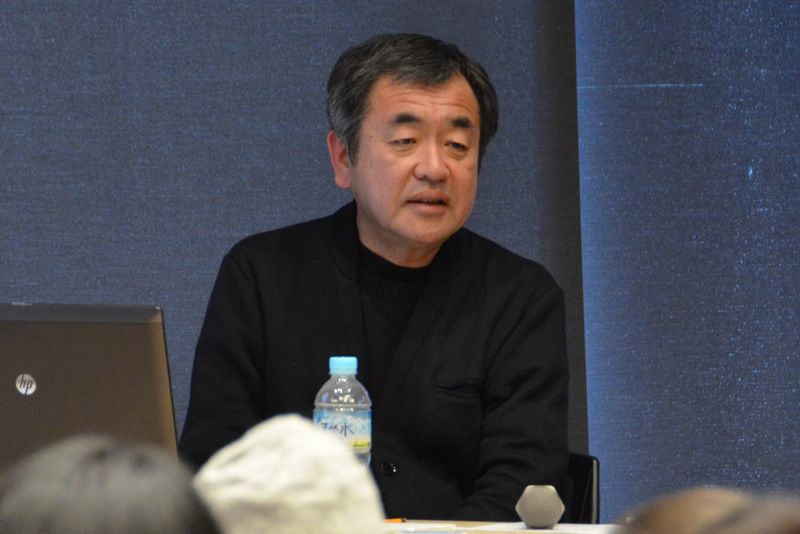 Kuma Kengo speaking about the construction of the fifth Kabukiza during an event at the Suntory Museum of Art in February.
Kuma Kengo speaking about the construction of the fifth Kabukiza during an event at the Suntory Museum of Art in February.
The fifth Kabukiza was designed by the architect Kuma Kengo in cooperation with Mitsubishi Jisho Sekkei, Inc. According to Kuma, “Following the disasters of March 2011, we have built the Kabukiza to be a symbol of Japan’s recovery from a terrible crisis, as both the third and fourth Kabukiza were. I have been deeply moved by the strange coincidence of fate in this.”
The building’s design has utilized distinctive exterior and interior features of the fourth Kabukiza while retaining the Azuchi-Momoyama architectural style of the third. As viewed from Ginza’s Harumi-dōri, with the dynamically curved karahafu roof over the entrance and the large hafu roofs on either side, the main facade gives is much the same feeling as before. As Kuma puts it, however: “Designing this took more than three times as much work as an ordinary building.” The architect paid careful attention to the details of material and construction, as well as to maintaining the Kabukiza’s former appearance. The building needs to be resistant to earthquakes and other disasters, and Kuma and his team were tasked with creating a building that would still be in use 100 years from now.
One example of that attention to detail is the roof. The fourth Kabukiza was made from steel-reinforced concrete. In the latest version, steel beams produce similar rooflines to the previous building. The taruki rafters of the previous structure were also made of concrete. (Taruki are the rafters that run vertically down from the peak of the roof to the eaves, supporting the roof’s slope. They function as both a structural element supporting the roof and as a decorative element under the eaves.) This time, aluminum has been used to save weight. The specially commissioned rafters come from a Toyama Prefecture manufacturer whose metalwork techniques go back to the Edo Period (1603–1868), and each one is a slightly different shape. To keep the pieces clean the manufacturer applied a coating of powdered fluororesin to the aluminum, a choice made in part because the substance presents a soft appearance similar to plaster. To protect against rain, the karahafu roof features copper sheets covered by Sanshū tiles from Aichi Prefecture that convey both elegance and solidity.
When it came to retaining the former appearance of the Kabukiza, Kuma and his team found that different people had different ideas as to what that appearance should be. And when it came to faithfully restoring the former appearance of the old Kabukiza there was debate over which point in time to take as the reference. Kuma considered the historical context and strove to create a look that would “fit within the structure’s continuous transformation over time.”
The architect gives an example: “In selecting the exterior paint, we erected an actual-size wall in the factory and placed the tiles on top. We then tried various white paints and compared them. It seems that the third Kabukiza was pure white, but as the fourth was repainted many times, it ended up with a darkish tinge. It may actually be a bit strange to return it to pure white now. So to match our conception of the Kabukiza’s appearance we chose a white with a gentle cream tinge and a touch of yellow.”
The Kabukiza’s nighttime illumination, which alters with the seasons, was designed by a mother and daughter team of lighting designers, Ishii Motoko and Ishii Lisa-Akari.
The new theater is part of a multi-use development, Ginza Kabukiza, incorporating a 143-meter office building (Kabukiza Tower) with 4 floors below ground and 29 above. The modern, glass-fronted tower rising at the back of the development strikes a harmonious look with the theater by being set well back from the theater entrance on the Harumi-dōri side and finished primarily in unobtrusive white. Only the vertical portion of the building set off from the center rising directly from the Kabukiza is finished in glass; the side facing Shōwa-dōri, meanwhile, looks like an office tower.
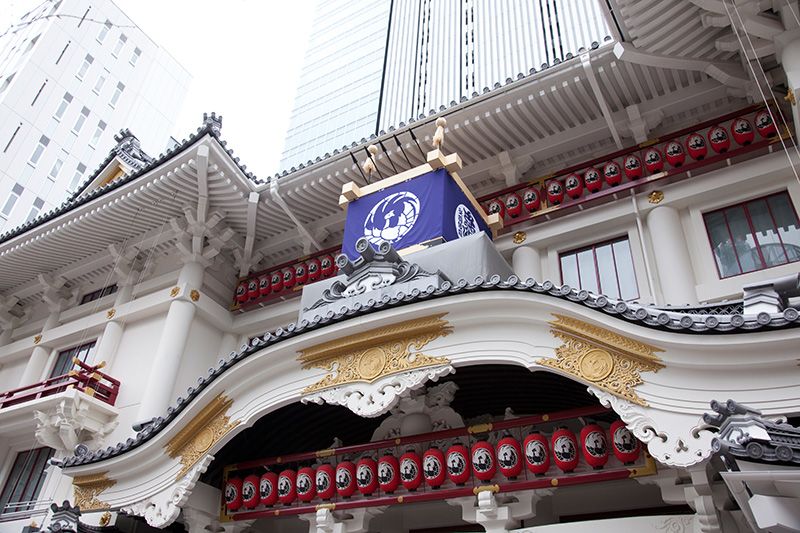 Rafters visible under the eaves have a quite different look from the aluminum of which they are made. The gold decorations on the “karahafu” roof have been reused from the fourth Kabukiza.
Rafters visible under the eaves have a quite different look from the aluminum of which they are made. The gold decorations on the “karahafu” roof have been reused from the fourth Kabukiza.
Tradition on the Surface, Practical Innovation Beneath
On its second basement level, the building connects directly with the Higashi-Ginza subway station. This connecting passage is known as the Kobikichō Hall—a moniker taken from the old name for the area around the Kabukiza—and it contains ticket counters and shops. In the event of a natural disaster, this underground facility has a stock of food and other supplies to feed and house up to 3,000 people stranded in the city center for around three days while they are unable to return home.
Above ground, a large covered walkway spans the route from the nearest subway stop to the front of the theater, allowing visitors to enter without getting wet when it rains while still enjoying views of the Kabukiza exterior.
On entering the theater, vistors are greeted by enveloping red decor, the feel of soft carpet under their feet, and a special atmosphere of pre-performance excitement. This foyer, known as the Ōma, is decorated with a vivid red carpet and red pillars that frame the Nishijin brocade from Kyoto decorating the walls. Lines of red paper lanterns hang high on the walls of the Ōma. Here, too, the designers have re-created the appearance of the fourth Kabukiza using modern technology.
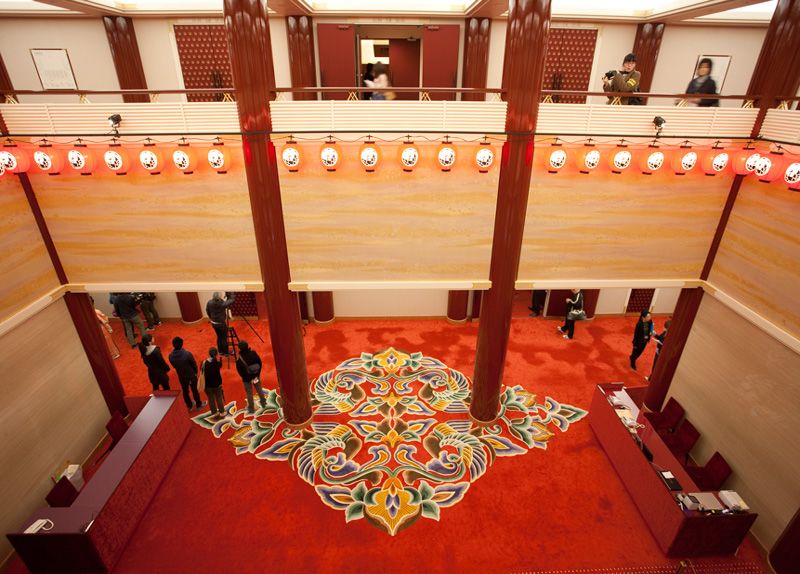 The Ōma main entrance foyer. The carpet features a brightly coloured design from the Hōōdō hall of Byōdōin temple in Uji, Kyoto Prefecture.
The Ōma main entrance foyer. The carpet features a brightly coloured design from the Hōōdō hall of Byōdōin temple in Uji, Kyoto Prefecture.
The auditorium is another faithful reimagining of the appearance of the fourth Kabukiza. The dimensions of the stage match those of the previous theater precisely, at 27.4 meters wide and 6.4 meters tall. Also the same size as the previous theater’s accoutrements are the circular rotating stage, 18.2 meters in diameter, and the 18.2 meter hanamichi. (Literally “flower path,” the hanamichi is a walkway extending from the stage through the audience by which actors make their grand entrances and exits.) The stage machinery is also largely the same size as in the previous Kabukiza, although the naraku—an access and storage area underneath the main stage and hanamichi—has been expanded to 16.4 meters in depth and a space for scenery has been created at the side of the ōnaraku, or main understage area. (The term naraku comes from a Buddhist name for hell, supposedly because the space is deep and dark.) The three traditional stage trapdoors, known as matsu, take, and ume (pine, bamboo, and plum), have been supplemented with a fourth, larger access hatch to enable more rapid scene changes.
The audience seats have been slightly reduced in number and arranged in a new layout, with straight lines of seats rather than staggered lines. The pillars between the first-floor seats have been removed to make the space larger and greatly improve visibility. In designing the interior space, Kuma and his team checked the line of sight from each seat to the stage and ensured that every single seat offered clear views of the stage and hanamichi.
To help prevent viewers from tiring during long performances, the designers widened the seats by 3 centimeters compared to the fourth Kabukiza and added 6 centimeters in between each seat and the one in front. The phoenix pattern on the upholstery, a symbol of the Kabukiza, has been newly embroidered in luxurious gold thread. Viewers can also attach to the seats rented devices that display subtitles detailing plot summaries and highlights of the program, as well as information on kabuki music forms like nagauta, takemoto, tokiwazubushi, and kiyomoto. Those new to kabuki can use these monitors to enjoy the performance along with the existing audio guide, available in Japanese or English. To help people from overseas to learn more about kabuki, theater organizers are also planning visual guides in languages other than Japanese.
The acoustic environment has received particular attention, with the latest materials used for the walls and ceiling. Audio engineers carried out numerous simulations with a 1:10 scale model of the theater to ensure that reverberations were exactly the same as in the fourth Kabukiza. The theater may appear much the same as before, but impressive work has gone into the details to overcome technical difficulties and improve the various facilities and functions of the Kabukiza.
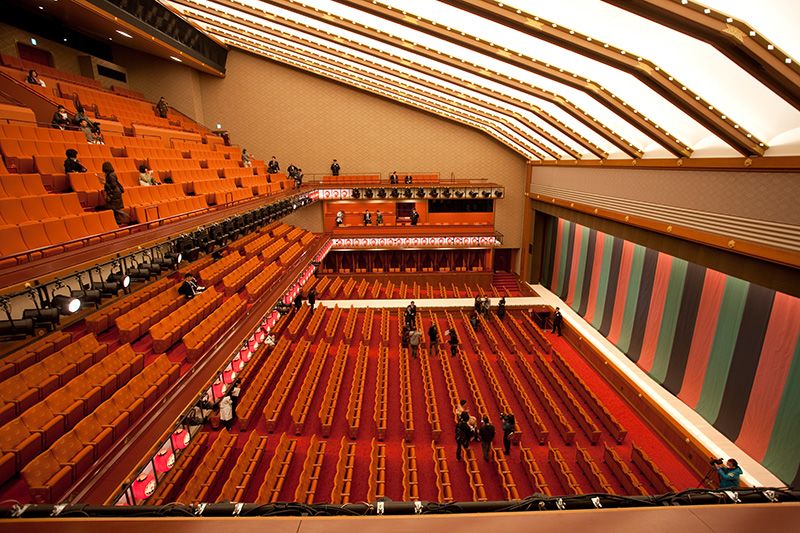 The Kabukiza has 1,808 audience seats on the first to third floors. There are also 96 inexpensive seats on the fourth floor known as “hitomaku-miseki” (one-act seats).
The Kabukiza has 1,808 audience seats on the first to third floors. There are also 96 inexpensive seats on the fourth floor known as “hitomaku-miseki” (one-act seats).
Passing Down New Memories
Another new feature of the theater is the Kabukiza Gallery on the fifth floor, which is open to the public as well as ticket-holders. There are plans to use the space to display historic video footage, costumes, props, and other items that normally cannot be seen up close. Another highlight of the structure is a 450 square meter rooftop garden adjoining the gallery. The garden contains memorial stones inscribed with the names of former Kabukiza luminaries, roof tiles depicting Japanese ogres from the fourth Kabukiza, and a stone lantern that once belonged to the kabuki dramatist Kawatake Mokuami (1816–93). The garden seems likely to become a popular tourist destination, along with the nearby Ginza shopping district and Tsukiji fish market.
With all this new functionality, it is clear that Kuma Kengo has done far more than simply recreate the look of the theaters of the past. The renovation of the building has even brought change to the surrounding area. In particular, Kobikichō-dōri, the street on the right-hand side when facing the Kabukiza, used to have the feel of a closed back street. But it now feels brighter thanks to a design employing trellises and greenery. “This is an age when people are returning to the city from the suburbs. We wanted the area around the Kabukiza to be a festive space where people can enjoy a leisurely stroll,” says Kuma.
The design of the fifth Kabukiza deftly incorporates modern facilities for today’s needs and features that appeal to the tastes of the general public. This is far more than just the preservation and restoration of past Kabukiza theaters. It is sure to continue to flourish with crowds of visitors as a place for new memories to be handed down to future generations.
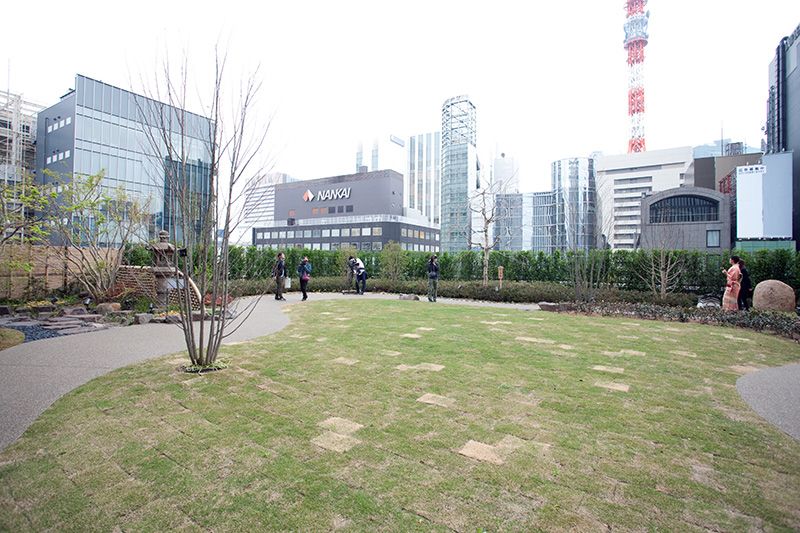 The Kabukiza’s rooftop garden.
The Kabukiza’s rooftop garden.
(Originally written in Japanese by Katō Jun, architectural writer. Photos by Kawamoto Seiya. Top photo courtesy Shōchiku Co., Ltd. With thanks to Kengo Kuma and Associates, Shōchiku Co., Ltd., and the Suntory Museum of Art.)